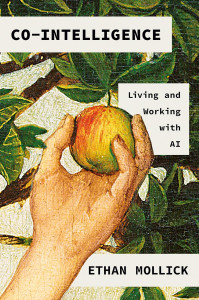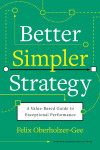Co-Intelligence
Living and Working with AI
"Co-Intelligence" examines the transformative shift from AI as a tool to AI as a collaborative partner. Ethan Mollick presents AI not as a replacement for human intelligence, but as a complementary force that enhances human capabilities when used strategically. The book focuses specifically on large language models (LLMs) like ChatGPT and their generative, flexible functionality that emulates human thinking patterns.
The book provides a realistic assessment of AI's current capabilities and limitations, particularly its tendency toward hallucinations and its inability to distinguish fact from fiction. Rather than dismissing these shortcomings, Mollick shows how to work with them productively. He demonstrates how AI's adaptability allows users to assign different personas and expertise levels, creating an "endless array of personalities and experts at your fingertips."
Through practical examples and research findings, the book explores three critical workplace applications: creative collaboration, job transformation, and learning acceleration. Mollick addresses common concerns about AI replacing human workers while showing how AI can free people to focus on more meaningful, strategic work that requires genuine critical thinking.
The book emphasizes that successful AI collaboration requires understanding when to delegate tasks, when to collaborate, and when to rely solely on human judgment. This approach treats AI as a powerful co-intelligence that amplifies human potential rather than diminishing it.
By reading Co-Intelligence, you will:
- Transform AI from mediocre assistant to thinking partner: Move beyond basic prompting to assign specific personas and expertise levels, creating what Mollick calls "an endless array of personalities and experts at your fingertips" tailored to each task.
- Harness AI's creative "hallucinations" productively: Learn why AI's tendency to fabricate information is actually a feature for innovation and brainstorming, while developing systems to verify outputs when accuracy matters.
- Avoid the "complacency trap" of high-quality AI: Understand research showing that better AI outputs make humans more likely to copy-paste without thinking, and develop habits to maintain critical engagement while gaining productivity benefits.
- Design AI collaboration that accelerates expertise: Use AI as a personalized mentor that provides real-time feedback and multiple perspectives, addressing how to gain skills when AI handles traditional entry-level learning opportunities.
Books to Follow:
- "The Alignment Problem" by Brian Christian: Explores the challenge of ensuring AI systems pursue intended goals without harmful side effects. While "Co-Intelligence" focuses on practical collaboration, this book addresses the deeper technical and philosophical challenges of aligning AI behavior with human values and intentions.
- "Human Compatible" by Stuart Russell: Provides a technical yet accessible examination of AI safety and the future of human-AI coexistence. Russell's framework for beneficial AI development complements Mollick's practical guidance by addressing long-term considerations for maintaining human agency in an AI-enhanced world.
- "Weapons of Math Destruction" by Cathy O'Neil: Examines how algorithms can perpetuate bias and cause harm when deployed without proper oversight. This critical perspective balances "Co-Intelligence" by highlighting the importance of human judgment in AI governance and the risks of uncritical AI adoption.
- "The Creativity Code" by Marcus du Sautoy: Investigates AI's potential in creative fields, from art to music to mathematics. While "Co-Intelligence" touches on creative collaboration, du Sautoy provides deeper exploration of what creativity means in the age of AI and where human creativity remains irreplaceable.
- "Robot-Proof" by Joseph Aoun: Focuses on education and skill development in an AI world, proposing a framework for "humanics" that combines technical literacy with human skills. This complements Mollick's discussion of learning and professional development by providing institutional perspectives on preparing for AI collaboration.
- "Algorithms to Live By" by Brian Christian and Tom Griffiths: Applies computer science concepts to human decision-making, showing how algorithmic thinking can improve daily life. This book bridges the gap between human and machine intelligence that "Co-Intelligence" explores, providing practical frameworks for thinking more systematically about problems.
AI as Co-Intelligence, Not Replacement
Successful AI collaboration treats artificial intelligence as a thinking partner rather than a replacement for human judgment. AI excels at pattern recognition, creative brainstorming, and rapid content generation, while humans provide critical thinking, quality control, and strategic direction. This partnership approach maximizes both AI capabilities and human strengths.
The Hallucination Feature, Not Bug
AI’s tendency to fabricate information, while problematic for factual tasks, becomes a creative asset when properly managed. This “hallucination” capability enables innovative brainstorming and creative problem-solving that purely factual systems cannot provide. The key is knowing when to harness this creativity and when to fact-check rigorously.
Persona-Driven Collaboration
AI’s adaptability allows users to assign specific personas and expertise levels for different tasks. You can ask AI to adopt the role of a business strategist, creative writer, or technical expert, tailoring both tone and approach to your needs. This flexibility creates access to diverse perspectives and specialized knowledge on demand.
The Complacency Trap
Higher-quality AI outputs create greater risk of human over-reliance and reduced critical thinking. Research shows that people working with impressive AI tend to copy outputs without adequate review, leading to decreased overall performance. Maintaining appropriate skepticism and verification processes becomes more important as AI quality improves.
Strategic Task Allocation
Effective AI collaboration requires analyzing your work to identify what should be delegated, collaborated on, or kept human-only. Tasks involving creativity, pattern recognition, and rapid iteration suit AI collaboration, while those requiring domain expertise, ethical judgment, and stakeholder relationships remain primarily human responsibilities.
AI as Learning Accelerator
AI can serve as a personalized mentor and learning partner, providing immediate feedback and multiple perspectives on your work. This capability addresses the challenge of reduced entry-level learning opportunities as AI handles routine tasks, enabling accelerated skill development through deliberate practice and real-time coaching.
Quality Control Through Process Design
Successful AI collaboration depends on building verification and quality control into workflows rather than relying on post-hoc checking. This includes designing prompts for consistency, establishing review processes, and creating feedback loops that improve both AI outputs and human oversight capabilities.
Q: How do I know when to trust AI outputs versus when to be skeptical?
A: Develop domain expertise and establish verification processes based on stakes and context. For creative brainstorming or first drafts, AI outputs can be starting points requiring human refinement. For factual information or high-stakes decisions, implement systematic fact-checking and multiple source verification. The key is matching your verification intensity to the potential consequences of errors.
Q: What makes AI collaboration different from just using AI as a tool?
A: Co-intelligence involves ongoing dialogue and iteration rather than one-off requests. You guide AI through complex problems, refine outputs together, and build on each other’s contributions. This collaborative approach treats AI as a thinking partner whose capabilities complement rather than simply replace human tasks.
Q: How can I improve my prompting skills for better AI collaboration?
A: Focus on context-setting, persona assignment, and iterative refinement. Provide clear background information, specify the role you want AI to adopt, and be prepared to refine requests based on initial outputs. The most effective prompts combine specific instructions with enough flexibility for AI to contribute creatively.
Q: Will AI collaboration make me less capable or dependent?
A: The risk exists but can be managed through deliberate practice and critical engagement. Use AI to accelerate learning rather than replace thinking. Regularly challenge yourself with tasks that require human judgment, maintain expertise in your domain, and view AI as a capability amplifier rather than a crutch.
Q: How do I handle AI’s tendency to hallucinate or provide incorrect information?
A: Build verification into your workflow rather than treating it as an afterthought. Understand that hallucination is inherent to current AI systems and design processes accordingly. For factual content, cross-reference multiple sources. For creative work, focus on the quality of ideas rather than factual accuracy.
Q: What tasks should I avoid delegating to AI?
A: Maintain human control over strategic decisions, ethical judgments, sensitive communications, and tasks requiring deep domain expertise or stakeholder relationships. AI can support these areas with research and analysis, but final decisions should remain with humans who understand context, consequences, and organizational dynamics.
Q: How do I convince my team or organization to adopt AI collaboration effectively?
A: Start with low-risk experiments that demonstrate clear value, address concerns about job displacement with realistic assessments, and focus on how AI enhances rather than replaces human capabilities. Share specific examples of productivity gains while being transparent about limitations and learning curves.
Q: What’s the difference between AI collaboration and traditional automation?
A: Traditional automation follows predetermined rules for repetitive tasks, while AI collaboration involves dynamic problem-solving and creative work. AI can adapt to new situations, engage in iterative dialogue, and contribute to tasks that previously required human creativity and judgment, creating partnerships rather than simple task replacement.
- When AI feels like a mediocre intern: You’ve tried ChatGPT or similar tools but results feel generic or unhelpful. The book reveals how to transform AI from a disappointing assistant into a capable thinking partner through strategic prompting and persona assignment.
- When you’re caught between AI hype and AI fear: Media coverage has you either convinced AI will solve everything or destroy your career. The book provides a realistic middle ground, showing AI’s genuine capabilities and limitations without the extremes.
- When you’re unsure what to trust from AI: You’ve noticed AI “hallucinations” or incorrect information and feel uncertain about when to rely on AI outputs. The book teaches you how to work productively with AI’s tendency to fabricate while maintaining appropriate skepticism.
- When creative work feels stuck in patterns: You want to break out of repetitive thinking or writer’s block but don’t want AI to replace your creative voice. The book shows how to use AI as a creative catalyst while maintaining your unique perspective and quality standards.

Your support helps me maintain and improve the book recommendations for everyone.



